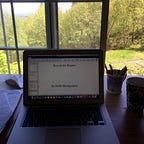Willamette Falls Locks reimagined today
The view from the Arch Bridge June 24, 2018. The mighty Willamette Falls on the left, shuttered locks channel on the right adjacent to now recently closed West Linn Paper Company.
How many in our bursting metro area know much about our aged Willamette Falls Locks? Ask a longtime local and they’ll fill your ear. The Locks opened on New Year’s Day 1873 and were operated by several owners prior to the U.S. Army Corps of Engineers’ purchase from Portland Railway Light and Power Company in 1912 for $375,000. The locks were placed on the National Register of Historic Places in 1974, but have been non-operational since late 2011 when the Corps deemed them to be unsafe. Their gates will remain closed until resources exist to repair this almost 150-year-old facility, and a new governance model for long-term operation is agreed upon.
Back in 1868, the Oregon Legislature approved an Act to appropriate funds for construction of a steamboat canal at “Wallamet Falls.” People then recognized how important it was to Oregonians to connect our lower and upper Willamette: our Willamette Falls — the second largest U.S. waterfall by volume — naturally divide urban Portland-metro area from rural and agricultural lands upstream. The Locks were built to allow marine vessels to bypass the Falls and move river traffic around the 40-foot horseshoe shaped basalt ridge between Oregon City and West Linn. Prior to 1873, passengers and freight were portaged around the Falls. For decades after, cargo laden boats — with winter wheat, produce, and the log rafts I most remember from my childhood — moved through the chambers of the locks to ports in the U.S. and around the world.
Creating the locks was a big deal — excavating over 50,000 cubic yards of rock and using almost 20,000 pounds of explosives. Between 300–500 men worked on the locks’ construction, including 100 of them working at night most of the time. Masons and stone-cutters earned $5-$6 per day, carpenters received $3–3.50 and laborers made $2.50.
Since the closing of the Locks, many economic and environmental benefits have been identified for reopening them, broadly related to river transportation, tourism and recreation. Earlier this year Governor Kate Brown appointed a 23-member Commission to oversee the potential recommissioning of the locks. This appointed Commission works to advise the various stakeholders and takes public comments and testimony as they chart the most appropriate path ahead.
It was only natural for me to write about the Locks in My Music Man, for I grew up learning the oldest stories about our river, and traveling through the locks myself as a Wilsonville river kid, its gates based on a Leonardo DaVinci design.
“I was a little girl. Dad was in his white, billed captain’s hat steering our boat, my brothers and I mesmerized by the spray of the river and the wake we generated as we headed downriver on a special Saturday…..onward we motored toward the Falls near the southern bank of the river…..Dad grabbed the ropes as we moved down, level by level, toward the water below: first, into the holding tank — the gate dropped and water spilled out, lowering our boat almost twenty feet. Dad grabbed a new rope, and we did it again.” (My Music Man, The Falls)
Dad died just a month before his favorite son-in-law decided to run for West Linn City Council in 2014, soon after securing a position on Council, elected mayor for a partial term, and now fulfilling a full four-year mayoral term. Back before Dad died, he and Mom joined me from their apartment across Salamo Road at West Linn’s City Hall to watch Russ at the dais as a West Linn Planning Commissioner. Dad was proud — issuing his often shared “that’s just so neat.” I can’t imagine how thrilled he would have been — to watch Russ preside over the Willamette Falls Locks Commission, now having been appointed Chair. For, not only was Dad a maritime historian and writer and an”Old Salt,” but he was, after all, proud to have been a member of the Royal Order of River and Wharf Rats.
What a historical, cultural and important environmental area we live near. The Willamette Falls Heritage Area, already designated as a State Heritage Area now seeks National Heritage Area status having recently submitted its feasibility study to the National Park Service. The Willamette Falls Heritage Area Coalition is a partnership of many public, private, and nonprofit organizations that share a common passion for the Willamette Falls, and the upriver history and stories. Learn more about the effort to reopen the locks from Oregon Solutions’ Willamette Falls Locks FAQ and further details from Unlocking the Locks: Willamette Falls, Oregon.
Then. Grab your kayak, get on your bike or stroll across the Arch Bridge or along either the Oregon City or West Linn side of the Willamette. Peer into the moving current holding remnants of long ago: Native Americans, industry, steamboats, canoes. Close your eyes and imagine those long ago times.
Originally published at dedemontgomery.com on June 27, 2018.
